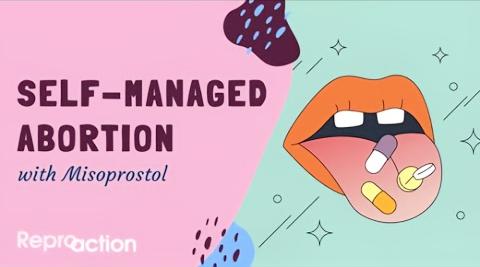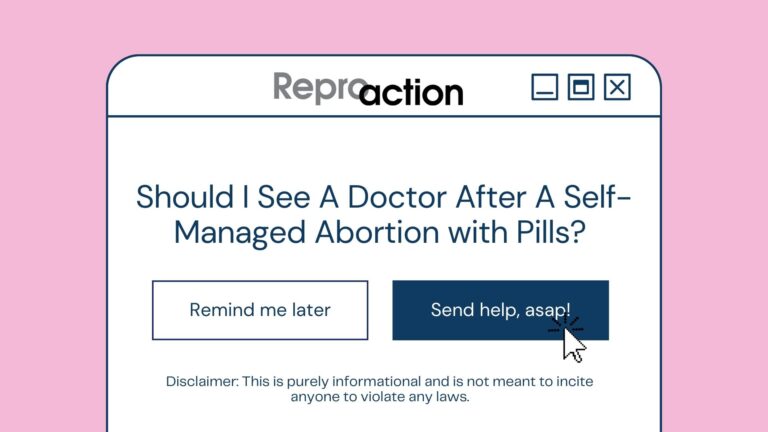
Understanding and Advocating for Self-Managed Abortion
Background
Self-managed abortion occurs when a person chooses to perform their own abortion outside a medical setting. There are many reasons why one may manage their own abortion outside a clinic setting. It may be because abortion care at a clinic is unavailable, inaccessible, or not desired by the individual.
Self-managed abortion is a broad term that includes all methods a pregnant person may use to end their own pregnancy, including medication, herbs, and manual aspiration. While no one should ever be shamed for choosing self-managed abortion, some methods may be safer and more effective than others.
At Reproaction, we focus our self-managed abortion education work on abortion with pills. Within the first 12 weeks of pregnancy, using the World Health Organization (WHO) protocol for self-managed abortion with misoprostol only is safe and approximately 85 percent effective in terminating a pregnancy. Using the WHO protocol for self-managed abortion with a combination of misoprostol and mifepristone is safe and approximately 95 percent effective in terminating a pregnancy in the first 12 weeks. The WHO has placed both misoprostol and mifepristone on the list of essential medicines.
About Self-Managed Abortion with Misoprostol
In the first 12 weeks of pregnancy, the WHO recommends that people who want to manage their abortion via misoprostol take a total of 12 misoprostol tablets (200 mcg each). These tablets are administered four at a time, under the tongue, and allowed to dissolve for 30 minutes, every three hours. The WHO protocol is summarized in the following steps:
- Place four pills (200 micrograms each) under the tongue for 30 minutes while tablets dissolve. Swallow the remnants of the pills after 30 minutes.
- After three hours, place four pills (200 micrograms each) under the tongue for 30 minutes while tablets dissolve. Swallow the remnants of the pills after 30 minutes.
- After another three hours, place four pills (200 micrograms each) under the tongue for 30 minutes while tablets dissolve. Swallow the remnants of the pills after 30 minutes.
A person will know the medication is working when they experience expected side effects as shared by the WHO, including: cramps, menstrual bleeding, nausea, vomiting, and diarrhea. Though rare, complications can occur. Signs of complications include:
- Heavy bleeding that lasts for more than two hours and soaks more than two sanitary pads per hour
- Severe pain that does not go away after hours after taking the medications
- A fever of over 102 degrees Fahrenheit
- Vaginal discharge that smells bad
Complications are rare. Treatment of the overwhelming majority of complications for abortion with pills is the same as treatment for complications of a miscarriage and therefore, in most cases, a person experiencing complications would not receive different care if they announced that they had taken abortion pills. (One notable difference would be if a person is displaying symptoms of shock, which might indicate an extremely rare allergic reaction. There have only been a few documented cases of this globally.) There are no tests that can detect the presence of misoprostol in the blood stream.
Between 2000 and 2020 there have been at least 60 cases where people have been criminally investigated or arrested for ending their pregnancy on their own or helping someone to do so. Often, these cases of unjust criminalization have occurred because of reporting by a medical provider a person visited after taking abortion pills. If/When/How’s free Repro Legal Helpline has lawyers who provide confidential consultation to help people who believe they need to seek medical care after taking abortion pills.
About Self-Managed Abortion with Misoprostol and Mifepristone
In the first 12 weeks of pregnancy, the WHO recommends that people who want to manage their abortion via misoprostol and mifepristone take a total of 5 pills, one mifepristone tablet (200 mg) and four misoprostol tablets (200 mcg each). The WHO protocol for this regimen is summarized in the following steps:
- A person should swallow one mifepristone tablet (200 mg) with water then wait 24 hours before proceeding with the medication abortion regime.
- After 24 hours, a person should place four misoprostol tablets (200 mcg each) between the cheek and gum with two on each side (four in total) and allow them to dissolve for 30 minutes.
A person will know the medications are working when they experience expected side effects as shared by the WHO, including: cramps, menstrual bleeding, nausea, vomiting, and diarrhea. The complications for this regimen are the same as for the misoprostol-only regimen.
Complications are rare. Treatment of the overwhelming majority of complications for abortion with pills is the same as treatment for complications of a miscarriage and therefore, in most cases, a person experiencing complications would not receive different care if they announced that they had taken abortion pills. (One notable difference would be if a person is displaying symptoms of shock, which might indicate an extremely rare allergic reaction. There have only been a few documented cases of this globally.) There are no tests that can detect the presence of misoprostol in the blood stream, and the most commonly used medical tests would not detect mifepristone in the blood stream.
Between 2000 and 2020 there have been at least 60 cases where people have been criminally investigated or arrested for ending their pregnancy on their own or helping someone to do so. Often, these cases of unjust criminalization have occurred because of reporting by a medical provider a person visited after taking abortion pills. If/When/How’s free Repro Legal Helpline has lawyers who provide confidential consultation to help people who believe they need to seek medical care after taking abortion pills.
Common Misconceptions about Self-Managed Abortion with Pills
Self-managed abortion with pills is not the same as using emergency contraceptives (commonly referred to as Plan B). Emergency contraceptives will prevent a pregnancy from occurring, but they will not end a pregnancy. If a person who needs an abortion takes emergency contraception in hopes of ending a pregnancy, they will not achieve the desired result and using time to pursue and take emergency contraception may extend the gestation of their pregnancy.
Self-managed abortion with pills is also not the same as getting abortion medications from a clinic and taking them at home. In a clinical setting, a pregnant person who wants to end their pregnancy is given a drug called mifepristone, which they may take in the presence of a medical provider. The pregnant person is also given misoprostol pills which they are instructed to take around 24 hours later at home. Or, clinical abortion providers may choose to dispense both drugs through telehealth through the first 10 weeks of pregnancy gestation. When an abortion with pills is self-managed, the pregnant person will procure and administer misoprostol or mifepristone plus misoprostol outside a clinical setting.
Access to Abortion Pills
Additional information can be obtained online through Aid Access, a doctor-supported telemedicine service. The service can help someone identify what options are available to someone in their state or territory.
Self-managed abortion with pills, while safe, can carry legal risks. To learn more or consult with a lawyer, the Repro Legal Helpline is available in multiple languages online or by phone at 844-868-2812.
Additional Resources
Why Is Reproaction Engaging with Self-Managed Abortion with Pills?
We envision a world where every person is respected in their right to parent, not to parent, and the right to raise children in safe and healthy communities. We believe that people are capable of determining what is best for their body, future, and health care – which includes the decision to have an abortion. Reproaction staunchly fights for more access to abortion within the medical system. So too, we respect the decision of people to end their pregnancies on their own and outside of a clinical setting.
The goal of Reproaction’s campaign on self-managed abortion is to raise awareness of self-managed abortion with pills in order to reduce stigma and build grassroots support to change unjust laws. We see raising public consciousness of self-managed abortion with pills as the first step in the journey to making misoprostol or a combination of mifepristone and misoprostol available to any pregnant person legally, affordably, and conveniently.
Campaign Resources
Campaign Coverage
FAQs About Self-Managed Abortion
The World Health Organization (WHO) protocol for self-managed abortion with pills includes instructions for vaginal as well as oral administration of the medications.
University Students Learn About Self-Managed Abortion
We must be vigilant about sharing information about self-managed abortion with pills, and how to be your own abortion provider safely and effectively.
Supporting a Friend’s Abortion At Home
To celebrate abortion at home, we’re bringing you five tips to support a friend managing their abortion at home
Six Things You Should Know About Abortion Pills
Abortion with a combination of mifepristone and misoprostol is 96.7 percent effective while abortion with just misoprostol is about 85 percent effective in the first 12 weeks of pregnancy.
Take Action
Reproaction is organizing activities in the DC metro area, Virginia, New York, and more. Activities include community forums, strategy sessions, campus presentations, and direct actions – to name a few.
Sign up for the Reproaction listserv to be the first to learn when activities are happening near you. Follow the action on social media with the hashtag #SelfManagedAbortion.


